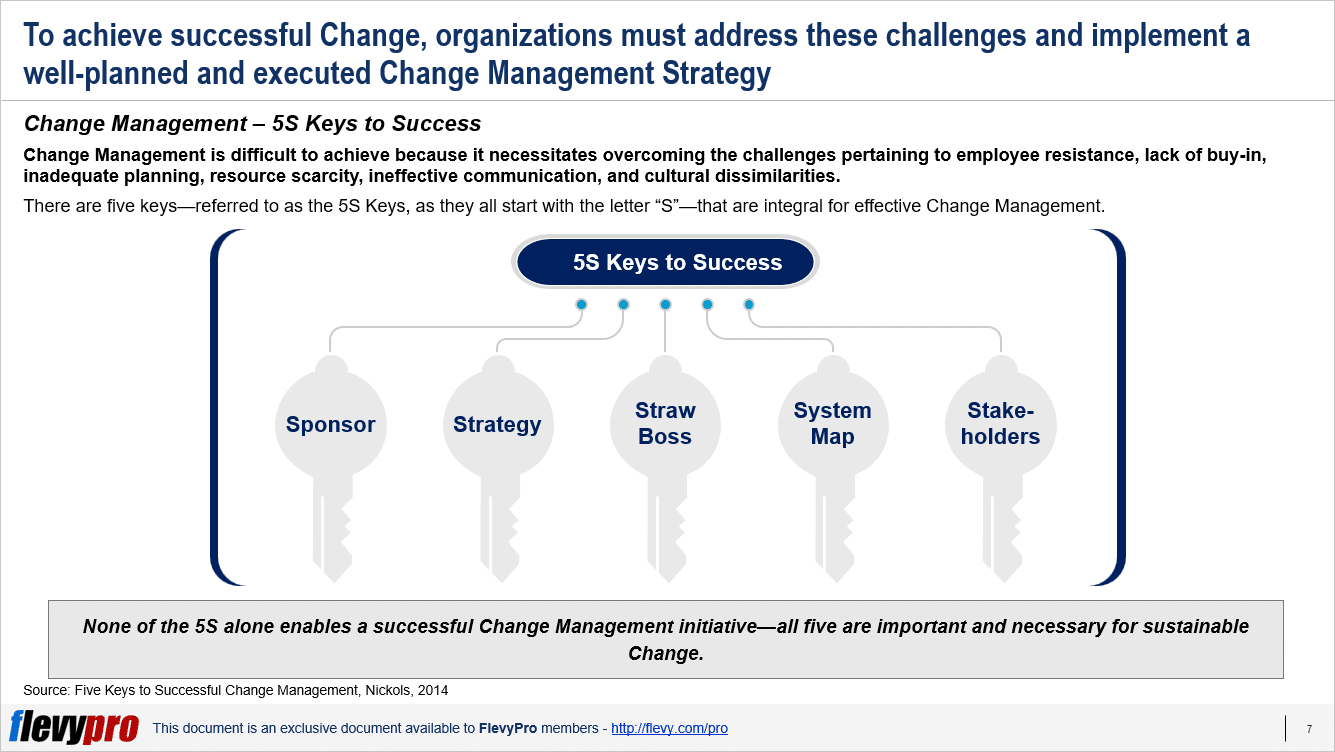
In the wake of disruption and intense competition, businesses need to keep changing and innovating in order to survive and thrive.
Although change is integral to the growth and profitability of an organization, it is often resisted by individuals and groups within the organization, making it a challenging undertaking.
Change Management refers to the process of preparing and supporting individuals, teams, and organizations in making changes to their operations, processes, and structures.
Change Management dictates dealing with and overcoming key challenges hampering Transformation. These challenges include:
- Resistance to change: Change disrupts individuals’ routines and comfort zones, making them resistant to change. It instills in people a fear of the unknown, a lack of trust in the change, and a feeling of loss of control.
- Lack of commitment from stakeholders: Inadequate communication and engagement with key stakeholders results in failure to obtain buy-in and commitment from them, eventually ruining the change initiative.
- Poor planning and execution: Change Management requires a well-planned and executed strategy. Ineffective planning leads to confusion, delays, setbacks, and hurdles in the effective implementation of change.
- Inadequate resources: Change initiatives require resources, e.g., time, money, and people. Lack of resources hinders the appropriate execution of change and leads to poor outcomes.
- Communication breakdown: Change Management demands effective and consistent communication. Inadequacy or absence of communication leads to misunderstandings and resistance to change.
- Cultural differences: When implementing change in a global organization, cultural differences pose a significant challenge. Diverse cultures have different attitudes towards change, and their values and beliefs often clash with the change initiative.
To effectively implement change, organizations must address these challenges and implement a well-planned and executed Change Management Strategy.
In order to overcome any difficulties in executing Change initiatives, leaders need to carefully ponder over and make good use of the following 5 keys—referred to commonly as the 5S Keys, as they all start with the letter “S:”
- Sponsor
- Strategy
- Straw Boss
- System Map
- Stakeholders
None of the 5S alone enables a successful Change Management initiative—all five are important and necessary for sustainable change. Let’s now delve deeper into the details of the first 3 of these keys.
Sponsor
A Change Sponsor is the one who owns the Change initiative. The Change Sponsor ensures that the Change initiative is adequately staffed with capable and committed individuals and removes any barriers that may impede the progress of the initiative. This person invests in the Change initiative, supports it, serves as a change advocate, and has the power to make it happen. The Sponsor is typically a senior leader within an organization, who possesses considerable authority over the system undergoing modification. The Sponsor keeps an eye on the progress and provides feedback and guidance to the Change Management team.
Strategy
A Change Strategy provides a clear direction and road-map that outlines the steps required to achieve the desired change. These steps entail a set of planned actions that are meant to make it easier for stakeholders to accept change and deal with any problems that might come up. A Change Strategy assists in creating a sense of direction and purpose, essential for gaining buy-in from stakeholders. It helps in ensuring that stakeholders are involved and invested in the project, managing risks, and measuring success by setting clear criteria and metrics.
Straw Boss
The term “Straw Boss” in the context of Change Management refers to an informal leader or influencer who may not hold a leadership position within the organization but has significant influence over their colleagues. This individual heads the change initiative on the front lines with the support and backing of the sponsor. A straw boss can be a valuable ally in driving change adoption within an organization by using their influence to encourage colleagues towards change, act as a role model, and provide feedback to change managers about what is and isn’t working.
Interested in learning more about the other keys to effectively managing Change? You can download an editable PowerPoint presentation on 5S Keys to Successful Change here on the Flevy documents marketplace.
Do You Find Value in This Framework?
You can download in-depth presentations on this and hundreds of similar business frameworks from the FlevyPro Library. FlevyPro is trusted and utilized by 1000s of management consultants and corporate executives.
For even more best practices available on Flevy, have a look at our top 100 lists:










